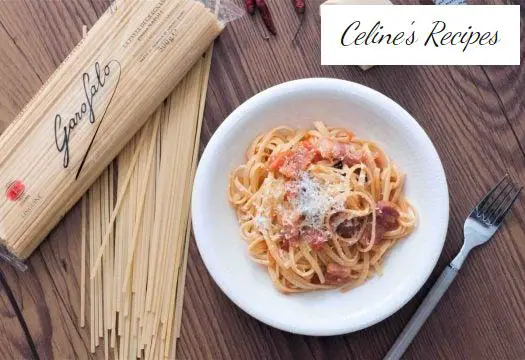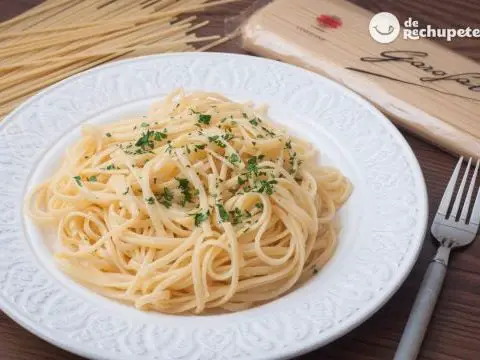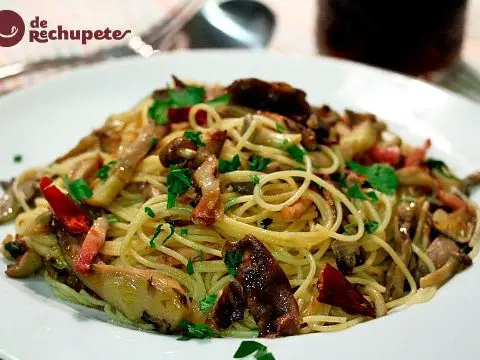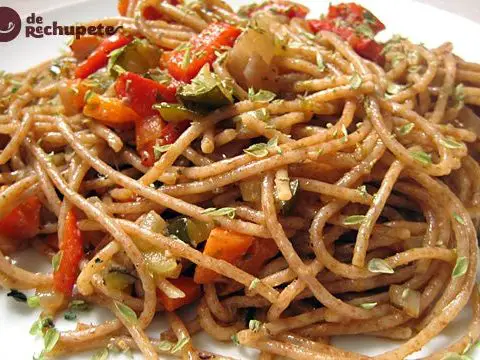
Info.
- Easy
- 40 minutes
- For 4 people
- 1.6 € / person
- 285kcal per 100g.
How to make pasta with Amatriciana sauce. Spaghetti alla Amatriciana.
The all’Amatriciana paste is a traditional dish of pasta made with a sauce made famous guanciale (pork jowl curing) or in our case pancetta, pecorino cheese and tomato.
It is one of the most internationally known sauces whose origin can be found in the city of Amatrice in the mountainous province of Rieti in the Lazio region.
These linguine or spaghetti all’Amatriciana will be, from the moment you prepare them, one of your favorites. How we are always going to use the appropriate long pasta for this recipe.
I recommend two types of Garofalo pasta, Linguine or Spaghetti that are made with durum wheat semolina with a rough surface that helps grip the Amatriciana sauce well.
The preparation of this dish is simple and the result is to lick your fingers.
Preparation of all’Amatriciana sauce
- We cut the bacon into strips and add it to a wide saucepan.
- We also add the chopped chilli or small pepper and cook until the bacon is golden brown.
- It is not necessary to add any type of oil, as the golden belly will release its own fat. We will not add salt either, since the cured bacon will already contribute its part.
- If we want to reduce the final itching of the dish somewhat, we can add the chopped chilli but removing its seeds.
- When the bacon is ready, remove the fat that may have been released, if it is in excess.
- Peel the tomatoes and cut them into small cubes. Add the chopped tomatoes to the casserole with the bacon and cook 15 minutes over low heat.
- While the sauce is cooking, we will cook the pasta.
Preparation of linguine or spaghetti
- The first step is to have the Amatriciana sauce ready before the linguine touches the water. The sauce should always wait for the linguine and not the other way around.
- We heat in a saucepan a liter of water for every 100 g of pasta, it is the recommended measure per person, except if we are passionate about linguine or spaghetti at home.
- These proportions, which are normally indicated on the packaging, help the paste not stick together. And always try to use a large casserole, the largest in your kitchen.
- When it begins to boil in spurts we add 1 generous handful of salt, about 2 level tablespoons for every 500 grams of pasta. Then we add the pasta, always all together.
- Stir with a wooden spoon so that the spaghetti does not stick and are loose.
- On the back of the package of pasta comes the cooking time, we must be guided by these instructions because for each type it is different, in this case it is 12 minutes of cooking .
- In this way we will achieve what is called pasta “al dente” or at the right point. In other words, do not miss it, although a great tip is to try it almost at the end.
Presentation of the pasta to the Amatriciana
- Once the time has elapsed we drain it immediately and combine it with the Amatracian sauce.
- We turn off the heat and stir well to integrate pasta and sauce.
- We serve the pasta and sprinkle a pinch of black pepper on each plate and a portion of pecorino cheese grated at the time
We can water the pasta with a thread of extra virgin olive oil in each dish, to the taste of the consumer.
You can see all the step by step photos of the recipe for these linguine with amatriciana sauce in this album. Do not miss any detail and they will be perfect, come on, repeat over and over again.
Curiosities about the Amatriciana sauce
- Before being called ” Amatriciana ” this sauce was called Gricia . This name derives from a village a few kilometers from Amatrice called Grisciano.
- The Gricia sauce is prepared with guanciale, pepitocino and extra virgin olive oil … but without tomato. For the tomato was known by the Amatricians when contacting the inhabitants of Rome, who in turn had adopted such a vegetable from the Neapolitans, and these, in turn, from the Spanish, who brought it to Europe from the New World.
- This is why after adding the tomato as one of its main ingredients, the sauce called “gricia” turned into the current Amatriciana sauce.






